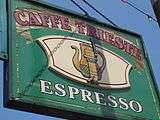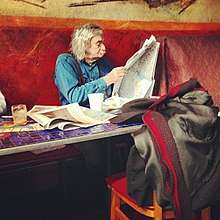Caffe Trieste
Caffè Trieste is an internationally known coffeehouse, retail store, and former franchise in San Francisco. The original cafe, opened in 1956, was the first espresso-based coffeehouse on the West Coast of the United States.[1][2] Caffe Trieste is considered a San Francisco institution and a local hub for poets, writers, and beat culture.[3][4]

.jpg)
History

In 1951, Giovanni Giotta (aka "Papa Gianni," 1920-2016) and his family emigrated to the United States from Italy. He had been born and raised in the small fishing town of Rovigno D'Istria, Croatia (a part of Italy before World War II), and had been living Monfalcone, Italy from 1947-51.[5][6] When Giotta first came to San Francisco, he experienced financial difficulties. He approached the priests at Saints Peter and Paul Church for help. As he explained, "We had nothing, no place to stay, no bread to eat. The father put us with a family and found me a job.” He worked as a window-washer and was known to sing while working.[7]
In the United States, Giotta missed the espresso houses of Trieste, Italy. American coffee culture of the 1950s focused on instant coffee that people made at home; people would purchase pre-ground beans that typically lacked flavor. By contrast, Trieste had a rich cafe history. It had been a part of both the Austro-Hungarian Empire and Italy, and was known for its blend of Italian, Austrian, Balkan, Greek, Venetian, and Jewish cultural influences. It was also known for its literary residents, such as James Joyce and Italo Svevo. Finally, the city was famous for its coffee. In 1719, Trieste had become a "free port" under Hapsburg law, and it became a key point in the trade of coffee beans from the Middle East to Europe. Cafes began to sprout up in Trieste as early as 1748; some historic cafes, such as Cafe Tommaseo (founded in 1830) and Caffè degli Specchi (founded in 1839) still exist in the twenty-first century. Coffee brands, such as Hausbrandt (founded in 1892) and Illy (founded in 1933) were also established in the city.[8][9][10][11][12]
In 1956, Giotta received the opportunity to take over Piccola Cafe, a small business located at 601 Vallejo Street in the North Beach. He renamed his new business Caffè Trieste, after the city of Trieste. The cafe was the first espresso house on the West Coast. Giotta imported and roasted the beans, which was not yet common in American cafe culture.[13][1][5][7] The cafe quickly became popular among the neighborhood's primarily Italian residents. "It was all Italian people," Giotta said of the neighborhood, "But I got the American people to like cappuccino."[14] For decades, the cafe has been known to have opera singers on Saturday.[3]
Franchise locations were opened in Berkeley (2004), Oakland, and Monterey.[2][15] In 2016, Caffe Trieste became a legacy business in San Francisco. That same year, Giotta passed away.[2] In 2017, a family dispute broke out over the management and future of the business.[2][16] As a result, the Berkeley and Oakland locations, which were under the ownership of 4 Musketeers, S.P. LLC, severed ties with Caffe Trieste and changed the names of the business in 2017. They cited the family dispute as the reason behind the move.[17]
Meeting place for authors and artists

Caffè Trieste became a convenient meeting place for Beat movement writers like Lawrence Ferlinghetti (still a regular), Alan Watts, Jack Kerouac, Allen Ginsberg, Richard Brautigan, Bob Kaufman, Gregory Corso, Michael McClure, Kenneth Rexroth, and Neeli Cherkovski, who lived in North Beach in the 1950s and 1960s.[18] Jack Hirschman, former Poet Laureate of San Francisco, has also been a regular patron. In addition to other writers and poets, painters such as Peter Le Blanc and Don Moses and photographers Joe Rosenthal (Pulitzer Prize winner), Jimo Perini, and Christopher Felver, other celebrities counting themselves among the Trieste Aficionados include Paul Kantner, Jack Sarfatti, Joey Reynolds and Mal Sharpe.
San Francisco politician Aaron Peskin is also a cafe regular.[19]
Local figures have discussed the cultural impact of the cafe. As described by Mark Bittner, "I think of Caffe Trieste as one of the last strongholds—actually the true center— of what made this neighborhood so fabulous." Tony Long, local journalist and author, described it as the "living room" of its regulars. Jack Hirschman remembered, "When I arrived in 1972, (Papa Gianni’s sister) Iolanda fed me for about 6 months because I had no money. Much later, before the official celebration at Koret Auditorium for my becoming Poet Laureate, Ida and The Trieste held a party for me first."[2]
The cafe has been featured in several movies, on television, radio, in magazines, and in dozens of photography, tourism and other books, ranging from local to national and international in scope.[20][21] Francis Ford Coppola wrote much of the screenplay for The Godfather while sitting in the Caffè Trieste.[13][22]
.jpg) Papa Gianni (left) in 2013
Papa Gianni (left) in 2013.jpg) Jack Hirschman & Lawrence Ferlinghetti
Jack Hirschman & Lawrence Ferlinghetti.jpg) Playing chess
Playing chess.jpg) Music
Music
See also
References
- "North Beach's Caffe Trieste Offers Patrons History Alongside Strong Espresso". Foodable Network. Retrieved 2020-06-30.
- "Trouble Brewing: Lawsuit May Force Closure Of Caffé Trieste". Hoodline. Retrieved 2020-06-30.
- "Caffé Trieste - FoundSF". www.foundsf.org. Retrieved 2020-06-30.
- Pandell, Lexi. "Caffe Trieste, San Francisco - Cafe Review". Condé Nast Traveler. Retrieved 2020-06-30.
- "Our Story – Caffe Trieste". Retrieved 2020-06-30.
- "IN MEMORIAM – Papa Gianni – Caffe Trieste". Retrieved 2020-06-30.
- "The fight for the bohemian soul of North Beach's Caffe Trieste". SF Weekly. 2008-12-10. Retrieved 2020-06-30.
- Chris Leadbeater, Travel writer. "The unheralded Italian city that put the coffee in your cup". The Telegraph. Retrieved 2020-06-30.
- Ruta, Francesco. "The Illy logo - History and evolution". Museo del Marchio Italiano. Retrieved 2020-06-30.
- Hoover, By Bob. "A portrait of James Joyce in Trieste". chicagotribune.com. Retrieved 2020-06-30.
- Burton, Tara Isabella (2015-12-03). "A Trip to Trieste: Italy's Most Beautifully Haunting City". Wall Street Journal. ISSN 0099-9660. Retrieved 2020-06-30.
- Davies, Lizzy (2013-05-29). "Italian literati in campaign to save Trieste's historic Caffè San Marco". The Guardian. ISSN 0261-3077. Retrieved 2020-07-01.
- "Caffe Trieste's Influence Percolates Through Area" The Wall Street Journal, February 11, 2010
- "50 Years of Art and Coffee" by Cecilia M. Vega, San Francisco Chronicle, April 1, 2006
- "Caffe Trieste Locations". www.caffetrieste.com. Retrieved 2020-06-30.
- Egelko, Bob (2017-08-17). "Caffe Trieste, popular North Beach landmark, roiled by family feud, lawsuit". SFGate. Retrieved 2020-07-01.
- Han, Sarah (2018-01-03). "Bites: Sliver closes, Caffè Trieste changes names, Bonchon opens, B-Dama to Alameda". Berkeleyside. Retrieved 2020-07-01.
- Mick Sinclair, San Francisco: A Cultural and Literary History (Signal Books, 2004), page 176
- Eskenazi, Joe (2017-08-10). "Prince of the City: Aaron Peskin finds ways to 'get to yes'". J. Retrieved 2020-07-01.
- Ira Nowinski with Charles Wehrenberg, Rebecca Solnit, et al., Ira Nowinski's San Francisco, The Bancroft Library/Heyday Books, Berkeley, p.56/57, ISBN 1-59714-040-6
- Ira Nowinski with Lawrence Ferlinghetti, Allen Ginsberg, et al., Cafe Society: Photographs and Poetry from San Francisco's North Beach, A Seefood Studios Book, San Francisco 1978, ISBN 0-916860-05-1
- "Gianfranco Giotta dies, owner of Caffè Trieste" SF Gate, September 19, 1999
External links
| Wikimedia Commons has media related to Caffe Trieste. |
- Official website
- Caffè Trieste Photo Gallery by Christopher Michel
- "Caffe Trieste's Influence Percolates Through Area" The Wall Street Journal, February 11, 2010